An Exploration of the Association Between Residents’ Sentiments and Street Functions During Heat Waves—Taking the Five Core Urban Areas of Chengdu City as an Example
Abstract
1. Introduction
1.1. Studies on Heat Waves and Healthy City Construction
1.2. Urban Resilience and Residents’ Sentiments
1.3. Residents’ Sentiments During Heat Waves
1.4. Urban Functional Layout and Residents’ Sentiments
1.5. The Validity of Techniques and the Purpose of Study
2. Study Area
3. Research Data and Methods
3.1. Research Data
3.1.1. Social Media Weibo Data
3.1.2. POI Data
3.1.3. Basic Geographical Data
3.2. Method
3.2.1. Calculating SDHW Based on Weibo Data
3.2.2. Calculating the Distribution of Urban Functional Categories Based on POI Data
3.2.3. Correlation Analysis
4. Results
4.1. Spatial Distribution Patterns of SDHW
4.2. Spatial Distribution Patterns of FCS
4.3. Associations Between SDHW and FCS
4.3.1. Associations Between SDHW and One Single FCS
4.3.2. Associations Between SDHW and Combined FCS
5. Discussion
5.1. Summary of Key Findings
5.2. The Exploration of the Association Between SDHW and FCS
5.2.1. SDHW
5.2.2. The Association Between SDHW and FCS
5.3. Implications
5.3.1. Improvement of Green Coverage and Building Efficiency
5.3.2. Improvement of Public Facilities
5.3.3. Focus on Aging-Friendly Areas
5.4. Limitations and Future Research
6. Conclusions
Author Contributions
Funding
Data Availability Statement
Conflicts of Interest
Abbreviations
| SDHW | Sentiments during heat waves |
| FCS | Functional categories of streets |
| TCS | Traffic category of streets |
| CCS | Commercial category of streets |
| GPCS | Green spaces and parks category of streets |
| RCS | Residential category of streets |
| ICS | Industrial category of streets |
| PCS | Public category of streets |
References
- Almendra, R.; Loureiro, A.; Silva, G.; Vasconcelos, J.; Santana, P. Short-term impacts of air temperature on hospitalizations for mental disorders in Lisbon. Sci. Total Environ. 2019, 647, 127–133. [Google Scholar] [CrossRef] [PubMed]
- Linchuan, Y.; Haosen, Y.; Qiangxue, F.; Guilin, Z.; Bingjie, Y. Vulnerability assessment and planning response to high-temperature wave in large cities: The case of Chengdu. Planner 2023, 39, 38–45. [Google Scholar]
- Shui, W.; Chen, Z.; Deng, J.; Li, Y.; Wang, Q.; Wang, W.; Chen, Y. Evaluation of urban high temperature vulnerability of coupling adaptability in Fuzhou, China. Acta Geogr. Sin. 2017, 72, 830–849. [Google Scholar]
- Huang, X.J.; Qi, M.Y.; Zhao, K.X.; Zheng, D.Y.; Liu, M.M. Assessment of population vulnerability to heat stress and spatial differentiation in Xi’an. Geogr. Res. 2021, 40, 1684–1700. [Google Scholar]
- UNISDR. Terminology on Disaster Risk Reduction; UNISDR: Geneva, Switzerland, 2009; Available online: https://www.undrr.org/publication/2009-unisdr-terminology-disaster-risk-reduction (accessed on 1 January 2025).
- Arup. City Resilience Index; Arup: London, UK, 2014; Available online: https://www.arup.com/insights/city-resilience-index/ (accessed on 1 January 2025).
- Li, Y.; Zhai, G.; Gu, F. Review on methods of quantification of urban infrastructure resilience. Urban Dev. Stud. 2016, 23, 113–122. [Google Scholar]
- Wang, L. Exploring a knowledge map for urban resilience to climate change. Cities 2022, 131, 104048. [Google Scholar] [CrossRef]
- Wang, B.; Loo, B.P.; Zhen, F.; Xi, G. Urban resilience from the lens of social media data: Responses to urban flooding in Nanjing, China. Cities 2020, 106, 102884. [Google Scholar] [CrossRef]
- Ramakrishnan, S.; Wang, X.; Sanjayan, J.; Wilson, J. Thermal performance of buildings integrated with phase change materials to reduce heat stress risks during extreme heatwave events. Appl. Energy 2017, 194, 410–421. [Google Scholar] [CrossRef]
- Xia, Y.; Li, Y.; Guan, D.; Tinoco, D.M.; Xia, J.; Yan, Z.; Yang, J.; Liu, Q.; Huo, H. Assessment of the economic impacts of heat waves: A case study of Nanjing, China. J. Clean. Prod. 2018, 171, 811–819. [Google Scholar] [CrossRef]
- Huang, H.; Zhang, S.; Xiong, S.; Shi, C. Health risk assessment and influencing factors analysis of high temperatures on negative emotions. Buildings 2022, 12, 1040. [Google Scholar] [CrossRef]
- Wang, J.; Obradovich, N.; Zheng, S. A 43-million-person investigation into weather and expressed sentiment in a changing climate. One Earth 2020, 2, 568–577. [Google Scholar] [CrossRef]
- Baylis, P. Temperature and temperament: Evidence from Twitter. J. Public Econ. 2020, 184, 104161. [Google Scholar] [CrossRef]
- Huang, H.; Liu, X.; Ren, L. Analysis of the spatiotemporal mechanism of high temperature on residents’ irritability in Beijing based on multiscale geographically weighted regression model. Front. Ecol. Evol. 2022, 10, 973365. [Google Scholar] [CrossRef]
- Shoval, N.; Schvimer, Y.; Tamir, M. Tracking technologies and urban analysis: Adding the emotional dimension. Cities 2018, 72, 34–42. [Google Scholar] [CrossRef]
- He, H.; Sun, R. Sentiment variations affected by urban temperature and landscape across China. Cities 2024, 149, 104933. [Google Scholar] [CrossRef]
- Zhong, W.; Suo, J.; Ren, X.; Li, G. The influence of emotional health on the activity characteristics of the elderly and the selection of environmental quality factors in residential areas. Int. J. Environ. Res. Public Health 2021, 18, 12618. [Google Scholar] [CrossRef]
- Su, X.; Wang, F.; Zhou, D.; Zhang, H. Heat health risk and adaptability assessments at the subdistrict scale in Metropolitan Beijing. Int. J. Disaster Risk Sci. 2022, 13, 987–1003. [Google Scholar] [CrossRef]
- Zheng, S.; Wang, J.; Sun, C.; Zhang, X.; Kahn, M.E. Air pollution lowers Chinese urbanites’ expressed happiness on social media. Nat. Hum. Behav. 2019, 3, 237–243. [Google Scholar] [CrossRef]
- Yang, L.; Liang, Y.; He, B.; Yang, H.; Lin, D. COVID-19 moderates the association between to-metro and by-metro accessibility and house prices. Transp. Res. Part D Transp. Environ. 2023, 114, 103571. [Google Scholar] [CrossRef]
- Weishan, C.; Lin, L.; Yutian, L. Retail center recognition and spatial aggregating feature analysis of retail formats in Guangzhou based on POI data. Geogr. Res. 2016, 35, 703–716. [Google Scholar]
- Sun, D.; Li, S.; Zheng, W.; Croitoru, A.; Stefanidis, A.; Goldberg, M. Mapping floods due to Hurricane Sandy using NPP VIIRS and ATMS data and geotagged Flickr imagery. Int. J. Digit. Earth 2016, 9, 427–441. [Google Scholar] [CrossRef]
- Wang, K.; Xu, Y. Questions and Answers to the Code for Classification of Urban Land Use and Planning standards of Development Land(GB 50137–2011)(I). City Plan. Rev. 2012, 4, 69–70. [Google Scholar]
- Zhang, L. Research on POI Classification Standard. Bull. Surv. Mapp. 2012, 10, 82–84. [Google Scholar]
- Xie, M.; Cheng, Y.; Fan, S. Identification of Urban Functional Areas in Fuzhou Based on POI data. Agric. Technol. 2023, 43, 107–112. [Google Scholar]
- Huang, H.; Jie, P. Research on the characteristics of high-temperature heat waves and outdoor thermal comfort: A typical space in Chongqing Yuzhong District as an example. Buildings 2022, 12, 625. [Google Scholar] [CrossRef]
- Shan, Z.; An, Y.; Yuan, M.; Huang, Y. Study on Spatial and Temporal Distribution Characteristics and Influencing Factors of Urban Residents’ Sentiment Based on Weibo Data: A Case Study of the Main Urban Area of Wuhan. Urban Dev. Stud. 2022, 29, 69–76+2. [Google Scholar]
- Zhu, Y.; Wang, J.; Yuan, Y.; Meng, B.; Luo, M.; Shi, C.; Ji, H. Spatial heterogeneities of residents’ sentiments and their associations with urban functional areas during heat waves—A case study in Beijing. Comput. Urban Sci. 2024, 4, 7. [Google Scholar] [CrossRef]
- Xing, Z. A study of the relationship between income and subjective well-being in China. Sociol. Stud. 2011, 1, 196–219. [Google Scholar]
- Cheng, Y.; Yu, Z.; Xu, C.; Manoli, G.; Ren, X.; Zhang, J.; Liu, Y.; Yin, R.; Zhao, B.; Vejre, H. Climatic and economic background determine the disparities in urbanites’ expressed happiness during the summer heat. Environ. Sci. Technol. 2023, 57, 10951–10961. [Google Scholar] [CrossRef]
- Ying, X. Thermal environment effects of urban human settlements and influencing factors based on multi-source data: A case study of Changsha city. Acta Geograph. Sin. 2021, 75, 2443. [Google Scholar]
- Gao, Y.; Chen, Y.; Mu, L.; Gong, S.; Zhang, P.; Liu, Y. Measuring urban sentiments from social media data: A dual-polarity metric approach. J. Geogr. Syst. 2022, 24, 199–221. [Google Scholar] [CrossRef]
- Conceição, M.A.; Monteiro, M.M.; Kasraian, D.; van den Berg, P.; Haustein, S.; Alves, I.; Azevedo, C.L.; Miranda, B. The effect of transport infrastructure, congestion and reliability on mental wellbeing: A systematic review of empirical studies. Transp. Rev. 2023, 43, 264–302. [Google Scholar] [CrossRef]
- Wakayama, M.; Mameno, K.; Owake, T.; Aikoh, T.; Shoji, Y. Climate change-induced heat reduces urban green space use: Insights from mobile phone location big data. Urban For. Urban Green. 2025, 107, 128771. [Google Scholar] [CrossRef]
- Salih, K.; Báthoryné Nagy, I.R. Review of the Role of Urban Green Infrastructure on Climate Resiliency: A Focus on Heat Mitigation Modelling Scenario on the Microclimate and Building Scale. Urban Sci. 2024, 8, 220. [Google Scholar] [CrossRef]
- Guo, F.; Dong, J.; Guo, R. A New Evaluation Method for Heat Exposure Risk Integrated With Outdoor Spatial Behaviour. World Archit. 2022, 9, 9296. [Google Scholar]
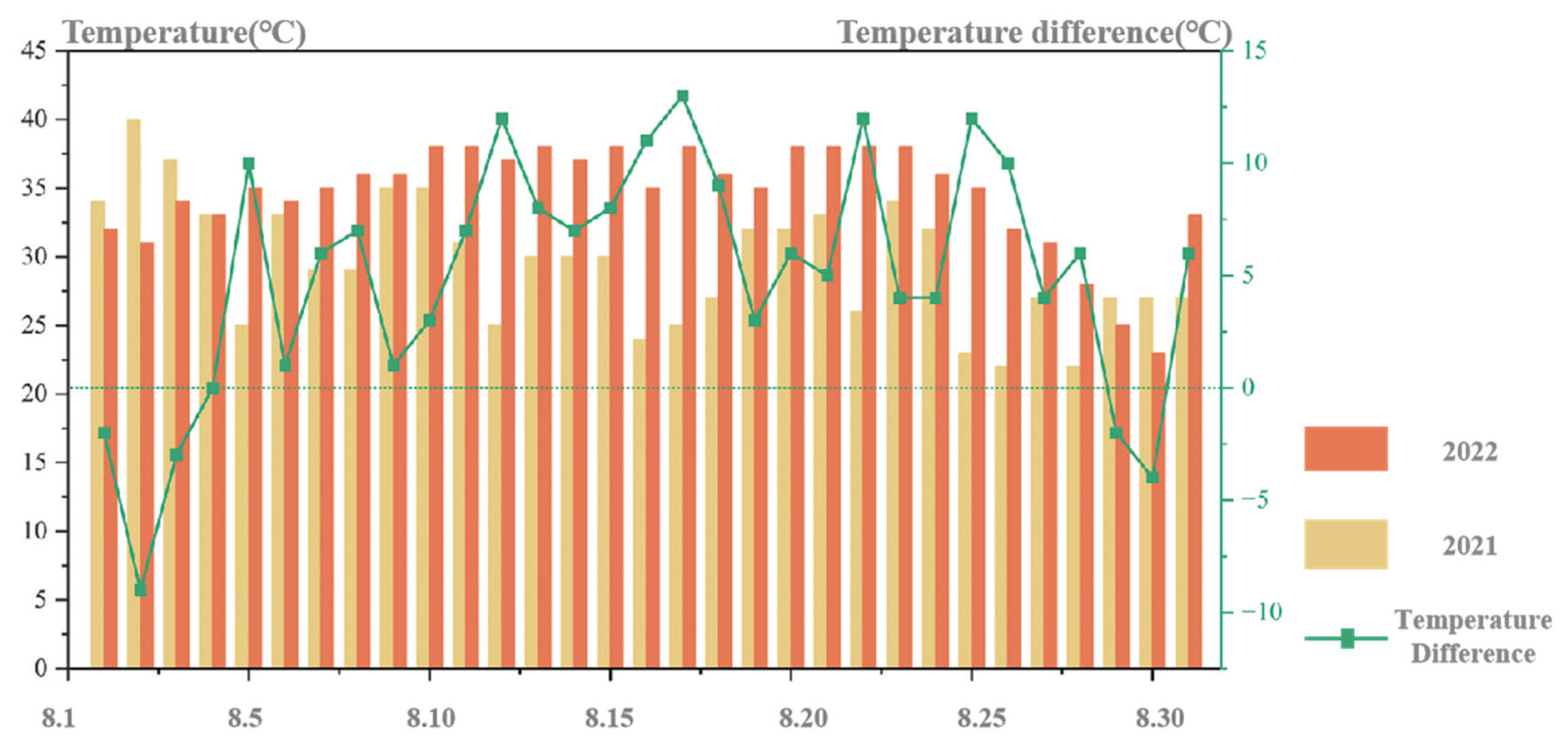

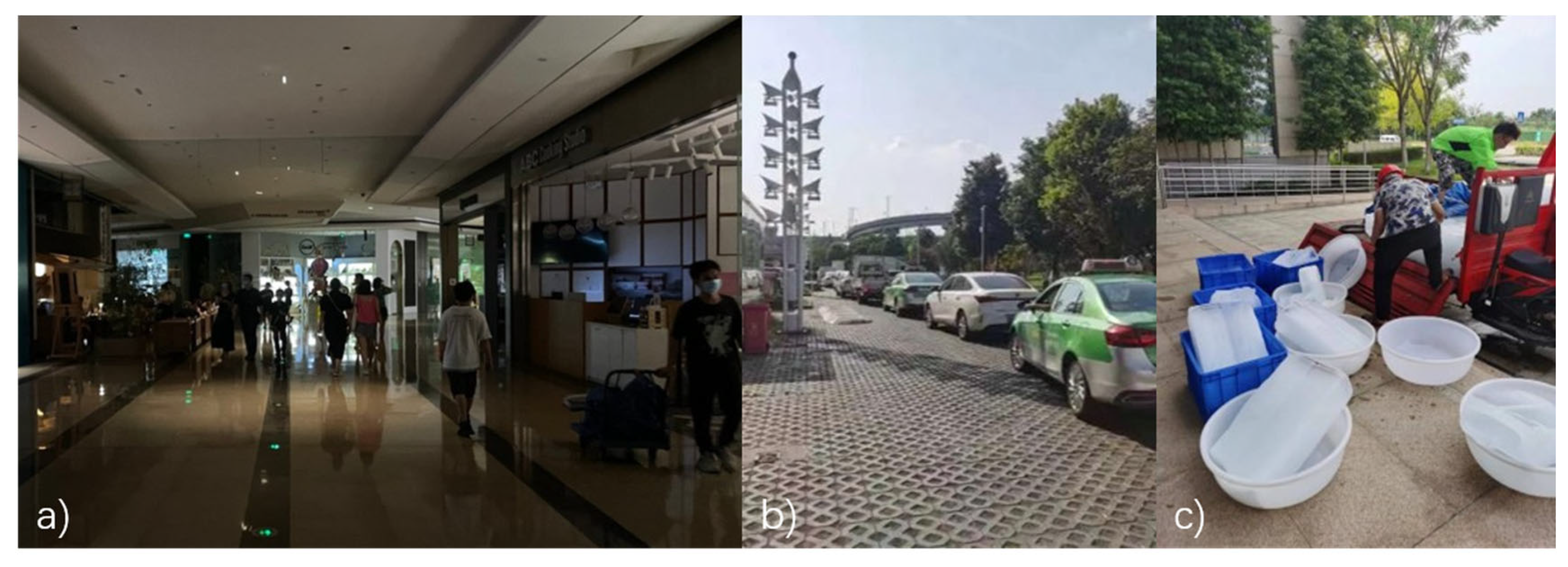
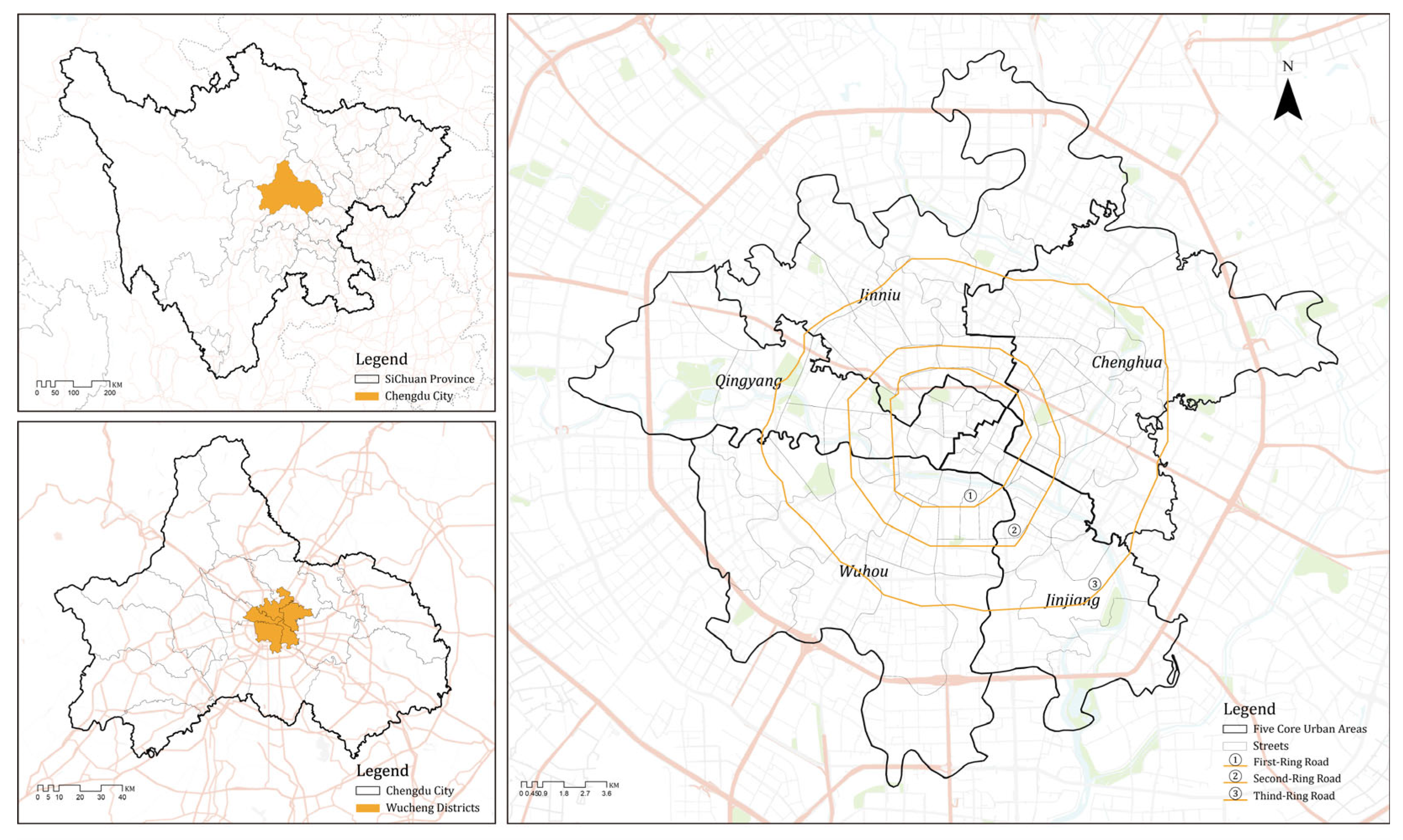
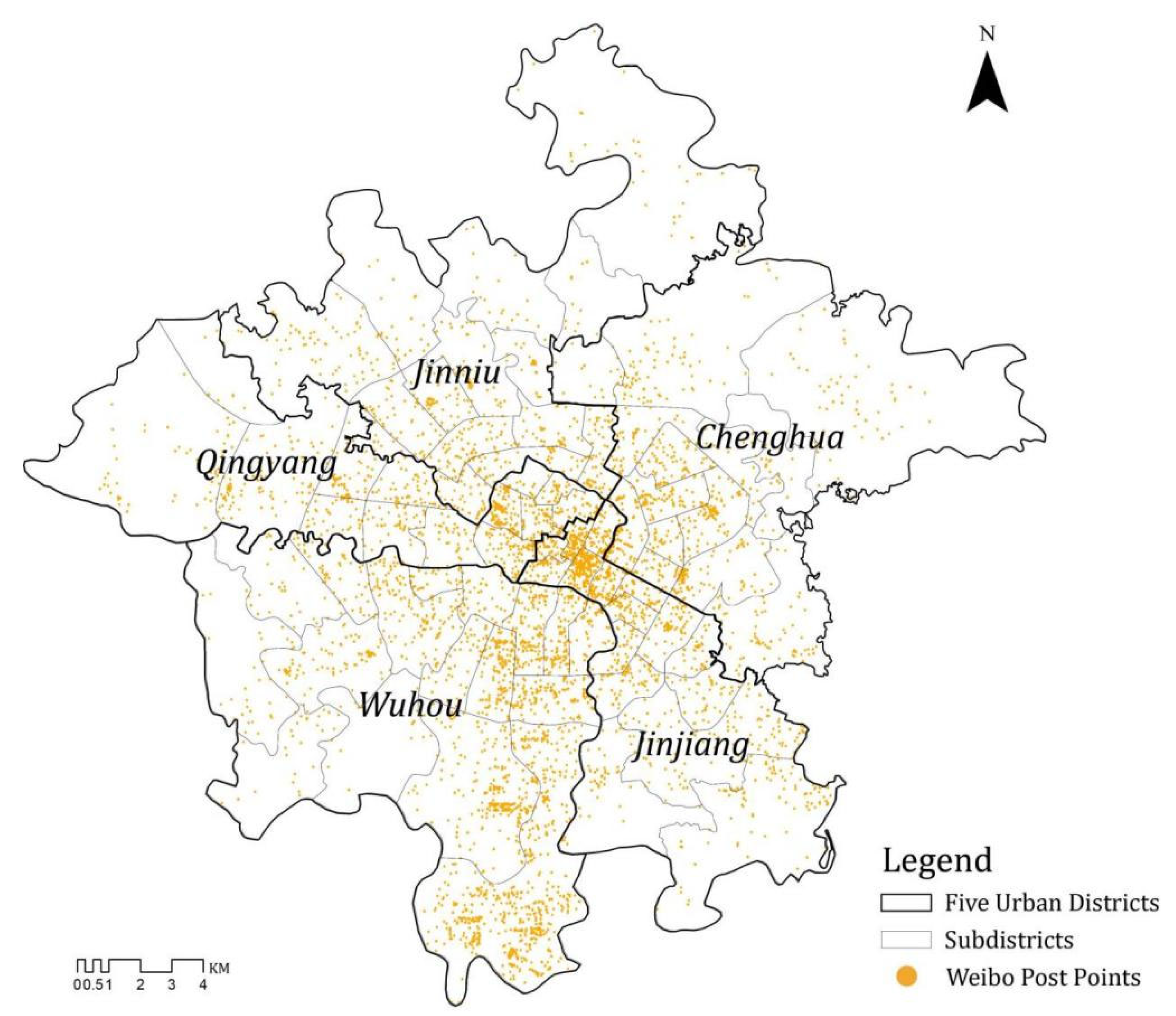

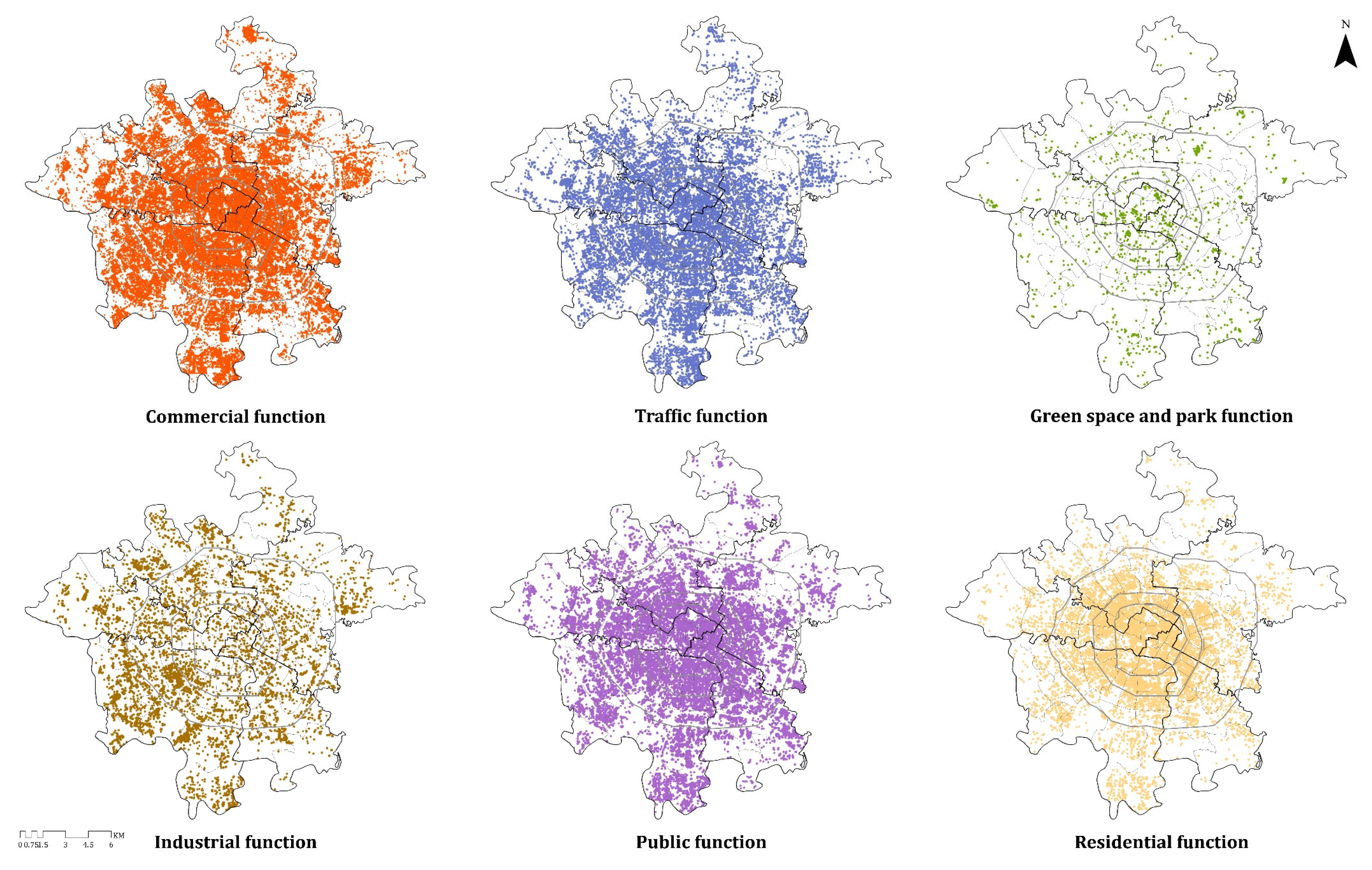



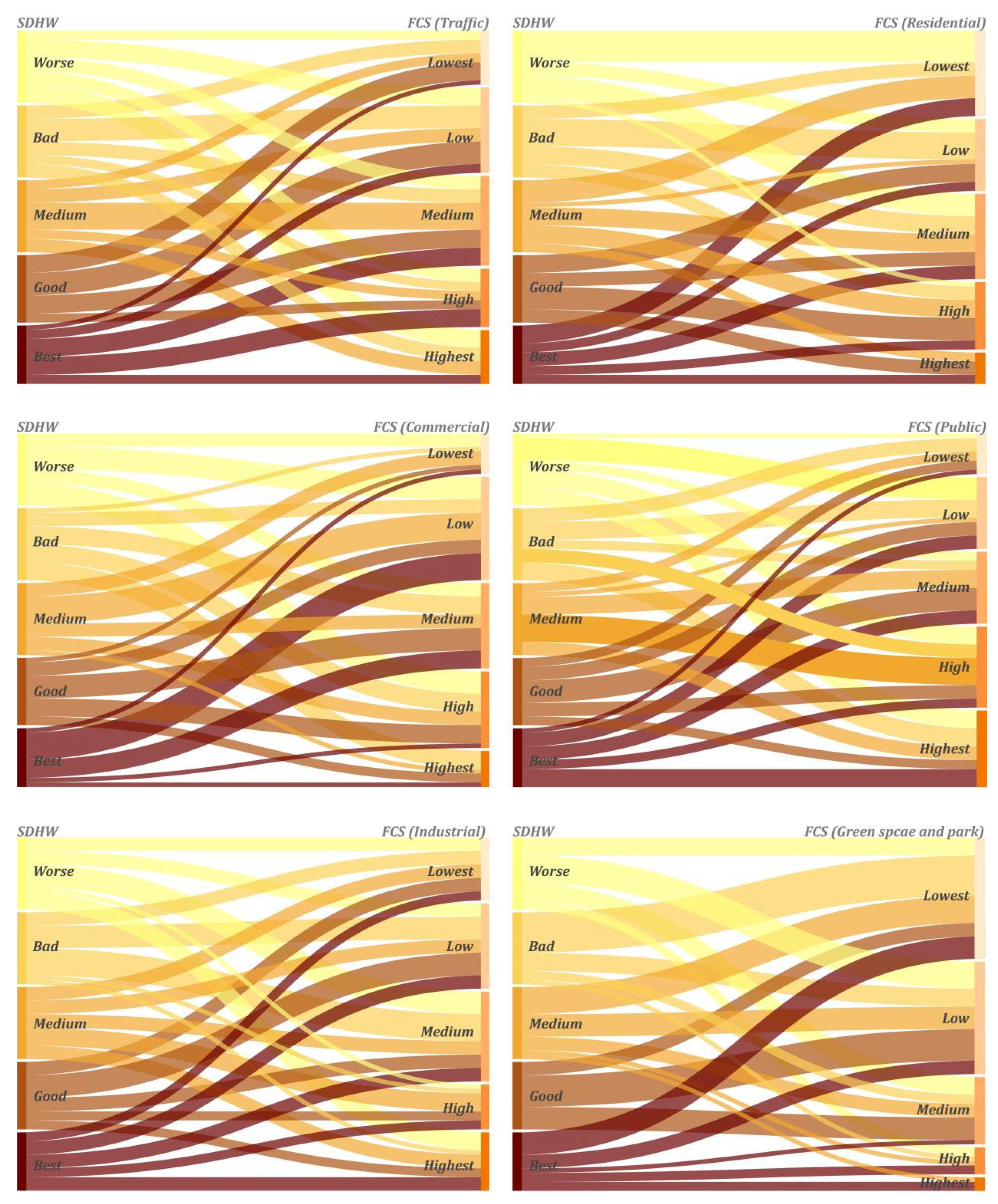
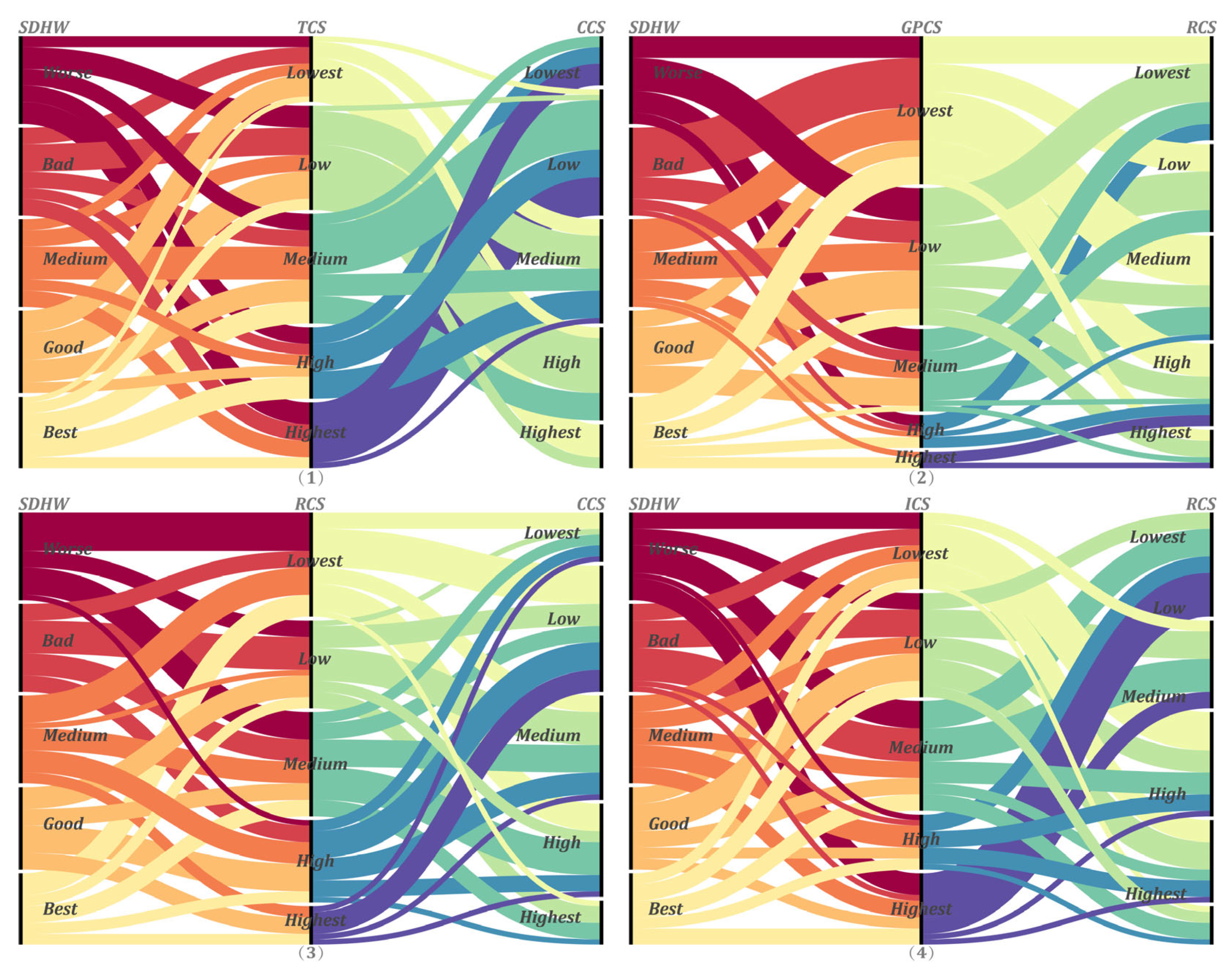



| Variable | Correlation with SDHW | ||
|---|---|---|---|
| ID | Multiple Urban FCS | Coefficient | p-Values |
| 1 | TCS, CCS | −0.11 | 0.03 ** |
| 2 | GPCS, RCS | 0.26 | 0.02 ** |
| 3 | RCS, CCS | 0.19 | 0.09 * |
| 4 | ICS, RCS | 0.28 | 0.01 ** |
| 5 | GPCS, CCS, RCS | 0.20 | 0.08 * |
| 6 | GPCS, ICS, RCS | 0.23 | 0.05 * |
| 7 | GPCS, PCS, RCS | 0.20 | 0.08 * |
| 8 | CCS, ICS, RCS | 0.31 | 0.01 ** |
| 9 | ICS, PCS, RCS | 0.23 | 0.04 ** |
| 10 | CCS, PCS, TCS | −0.17 | 0.03 ** |
Disclaimer/Publisher’s Note: The statements, opinions and data contained in all publications are solely those of the individual author(s) and contributor(s) and not of MDPI and/or the editor(s). MDPI and/or the editor(s) disclaim responsibility for any injury to people or property resulting from any ideas, methods, instructions or products referred to in the content. |
© 2025 by the authors. Licensee MDPI, Basel, Switzerland. This article is an open access article distributed under the terms and conditions of the Creative Commons Attribution (CC BY) license (https://creativecommons.org/licenses/by/4.0/).
Share and Cite
Hua, T.; Ru, Y.; Zhang, S.; Luo, S. An Exploration of the Association Between Residents’ Sentiments and Street Functions During Heat Waves—Taking the Five Core Urban Areas of Chengdu City as an Example. Land 2025, 14, 1377. https://doi.org/10.3390/land14071377
Hua T, Ru Y, Zhang S, Luo S. An Exploration of the Association Between Residents’ Sentiments and Street Functions During Heat Waves—Taking the Five Core Urban Areas of Chengdu City as an Example. Land. 2025; 14(7):1377. https://doi.org/10.3390/land14071377
Chicago/Turabian StyleHua, Tianrui, Yufei Ru, Sining Zhang, and Shixian Luo. 2025. "An Exploration of the Association Between Residents’ Sentiments and Street Functions During Heat Waves—Taking the Five Core Urban Areas of Chengdu City as an Example" Land 14, no. 7: 1377. https://doi.org/10.3390/land14071377
APA StyleHua, T., Ru, Y., Zhang, S., & Luo, S. (2025). An Exploration of the Association Between Residents’ Sentiments and Street Functions During Heat Waves—Taking the Five Core Urban Areas of Chengdu City as an Example. Land, 14(7), 1377. https://doi.org/10.3390/land14071377







